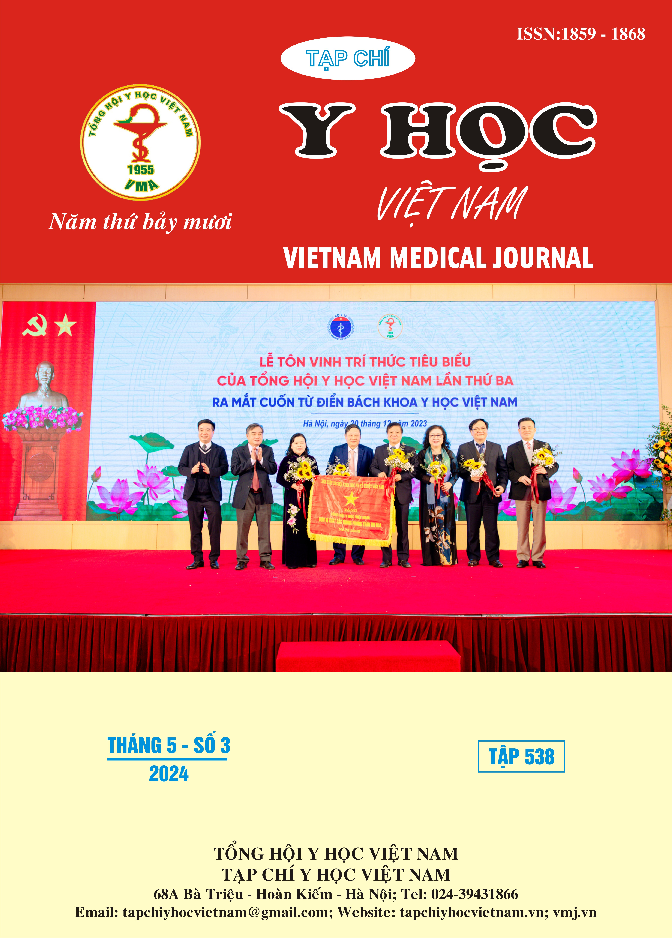EVALUATION OF THE EFFECTIVENESS OF REDUCING NECK AND SHOULDER PAIN DUE TO CERVICAL SPONDYLOSIS USING ELECTROACUPUNCTURE COMBINED WITH SHORTWAVE THERAPY AT TRADITIONAL MEDICINE HOSPITAL IN TRA VINH
Main Article Content
Abstract
Objective: Describe the clinical characteristics and cervical spine X-ray images of patients with cervical spondylosis treated at YDCT Tra Vinh Hospital. Evaluate the reduction in neck pain due to cervical spondylosis using electroacupuncture combined with shortwave therapy. Determine the correlation between treatment outcomes and factors such as age, gender, living environment, and occupation. Research Method: Interventional study, pre- and post-treatment comparison, without control group. Results: X-ray results showed the highest prevalence of osteophytes (92.9%). Subchondral sclerosis followed (90.5%), joint space narrowing (71.4%), and both joint space narrowing and osteophytes (66.7%). Pain levels at discharge decreased significantly compared to day 1, with a statistically significant difference of p<0.001. The correlation between some characteristics of the study subjects and pain reduction effectiveness showed that treatment outcomes were not dependent on age, gender, living environment, or occupation. Conclusion: Cervical spine X-ray images revealed osteophytes (92.9%), subchondral sclerosis (90.5%), joint space narrowing (71.4%), and both joint space narrowing and osteophytes (66.7%). Pain reduction from cervical spondylosis treatment using electroacupuncture combined with shortwave therapy showed excellent outcomes, with 92.9% reporting good pain relief and no patients experiencing poor or moderate pain levels at discharge. The average pain score significantly improved from 5.3 to 1.2. Evaluation of the correlation between various characteristics of the study subjects and pain reduction outcomes indicated that pain reduction was not dependent on age, gender, living environment, or occupation.
Article Details
Keywords
cervical spondylosis, electroacupuncture, shortwave therapy
References
2. Trần Ngọc Dương (1987), “Đánh giá tác dụng lâm sàng của điều trị hư xương sụn cột sống cổ bằng phương pháp kéo giãn cột sống cổ”, Luận văn tốt nghiệp Bác sĩ chuyên khoa cấp II, Học viện Quân y.
3. Lưu Thị Hiệp (2005), “Châm cứu học cơ bản và điều trị”, Nhà xuất bản Y học chi nhánh thành phố Hồ Chí Minh.
4. Phan Quan Chí Hiếu (2002), “Điện châm học – Tập 2”, Nhà xuất bản Y học, tr.176
5. Hồ Hữu Lương (2003), “Thoái hóa cột sống cổ và thoát vị đĩa đệm”, Nhà xuất bản Y Học Hà Nội, tr.10, 29, 31, 126.
6. Phạm Gia Nhâm, Lưu Thị Hiệp (2009), “Hiệu quả giảm đau và cải thiện vận động của điện châm trong điều trị thoái hóa cột sống cổ”, Luận án bác sĩ chuyên khoa cấp II, Trường Đại học Y dược Thành phố Hồ Chí Minh.
7. Nguyễn Tuyết Trang, Đỗ Thị Phương (2016), “Hiệu quả của phương pháp điện châm và cấy chỉ Catgut trong điều trị đau vai gáy do Thoái hóa cột sống cổ”, Tạp chí nghiên cứu y học, tr.17-23.


